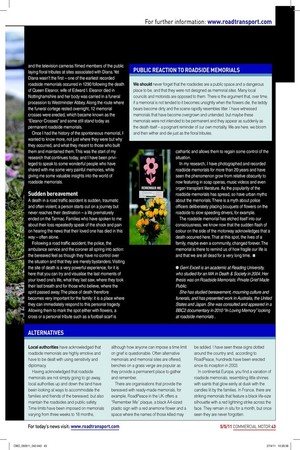ALTERNATIVES
Page 38

If you've noticed an error in this article please click here to report it so we can fix it.
Local authorities have acknowledged that roadside memorials are highly emotive and have to be dealt with using sensitivity and diplomacy.
Having acknowledged that roadside memorials are not simply going to go away, local authorities up and down the land have been looking at ways to accommodate the families and friends of the bereaved, but also maintain the roadsides and public safety. Time limits have been imposed on memorials varying from three weeks to 18 months, although how anyone can impose a time limit on grief is questionable. Often alternative memorials and memorial sites are offered, benches on a grass verge are popular as they provide a permanent place to gather and remember.
There are organisations that provide the bereaved with ready-made memorials, for example, RoadPeace in the UK offers a “Remember Me” plaque, a black A4-sized plastic sign with a red anemone flower and a space where the names of those killed may be added. I have seen these signs dotted around the country and, according to RoadPeace, hundreds have been erected since its inception in 2003.
In continental Europe, you find a variation of roadside memorials, resembling little shrines with saints that glow eerily at dusk with the candles lit by the families. In France, there are striking memorials that feature a black life-size silhouette with a red lightning strike across the face. They remain in situ for a month, but once seen they are never forgotten.
















































